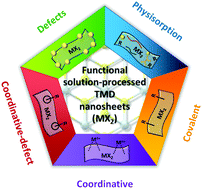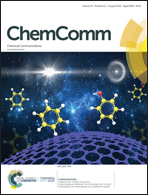Tailoring the physicochemical properties of solution-processed transition metal dichalcogenides via molecular approaches
Abstract
During the last five years, the scientific community has witnessed tremendous progress in solution-processed semiconducting 2D transition metal dichalcogenides (TMDs), in combination with the use of chemical approaches to finely tune their electrical, optical, mechanical and thermal properties. Because of the strong structure–properties relationship, the adopted production methods contribute in affecting the quality and characteristics of the nanomaterials, along with the costs, scalability and yield of the process. Nevertheless, a number of (supra)molecular approaches have been developed to meticulously tailor the properties of TMDs via formation of both covalent and non-covalent bonds, where small molecules, (bio)polymers or nanoparticles interact with the basal plane and/or edges of the 2D nanosheets in a controlled fashion. In this Feature Article, we will highlight the recent advancements in the development of production strategies and molecular approaches for tailoring the properties of solution-processed TMD nanosheets. We will also discuss opportunities and challenges towards the realization of multifunctional devices and sensors based on such novel hybrid nanomaterials.

- This article is part of the themed collection: Celebrating our 2020 Prize and Award winners


 Please wait while we load your content...
Please wait while we load your content...